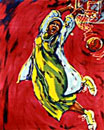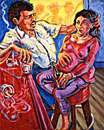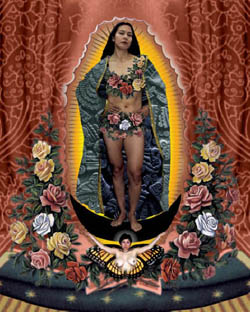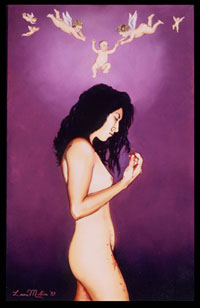Latina/o Art: |
 |
 |
Art and Inequality According to the definition of feminism, "feminists differ over the sources of inequality, how to attain equality, and the extent to which gender and gender-based identities should be questioned and critiqued." Additionally, feminism believes that gender is not a factor that determines one’s identity or social, economic rights 1. While the Chicano movement is represented by the male heroes, such as Rodolfo "Corky" Gonzales, Jose Angel Gutierrez, or Cesar Chavez, it might not have been successful without the participation of women. During the 1960's and 70's, a new group emerged – Chicana feminists – who expressed their own idea about gender-based discrimination, which they experienced during participation in the Chicano movement 2. Many Chicana feminst artists show their passion through their work; therefore, in order to understand Chicana feminism, it would be necessary to analyze the works of feminist Chicana artists.
"Alma Lopez is an artist, activist and visual storyteller working in painting, photo based digital prints, and video. She is internationally recognized for her innovative digital images, which recontextualize cultural icons bringing issues of race, gender and sexuality into relationship with transnationalist myths" 5. In her work "Our Lady" She uses "an image of a forty year old woman with her belly and legs exposed standing on a black crescent moon held by a bare breasted female butterfly angel" 6. The image depicted, the Virgin of Guadalupe, represents the strenght of women around East LA where Lopez grew up 7. She expresses her personal feelings about the iconic Guadalupe, "I was wanting to find a meaningful connection with La Virgen de Guadalupe. I am relating her to the women in my life, my mom, my grandma, my aunt. They had to be strong to survive, like Christ's mother" 8. Images focused on the strength of women, such as the Virgin of Guadalupe, are commonly used throughout Chicana feminist art.  Alma Lopez. "Our Lady." Juana Alicia introduces herself "as an artist to be an activist for social justice, human rights and environmental health, and I see the work of parenting and teaching akin to being an artist" 9. She discusses the United Farm Workers that protested the war in Vietnam in her work "A Woman’s Place". The mural is divided into the three sub-stories: evolution, revolution, and transformation. In this work, the butterfly, the central metaphor, symbolizes women who come and participate in the labor movement. "The growth and development of women’s power and leadership has required fierce, intelligent unity and persistence, particularly in the workplace. This metamorphosis has also happened within the family and our societies at large, as women have demanded full citizenship in every sphere of their lives." Normally women are more likely to be weaker than men, so more likely to be abandoned in society. In this work, Juana Alicia is "inspired by the courageous and positive examples of women who risked much to struggle for the welfare of all." Through the strong women, she tries to describe the triumphs of these working women 10. |
